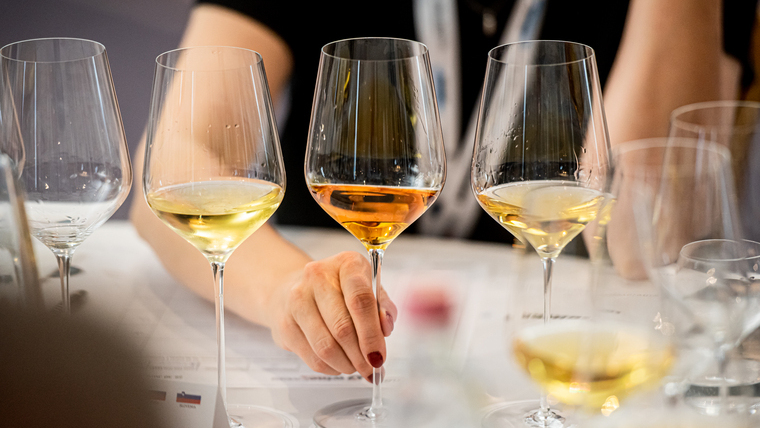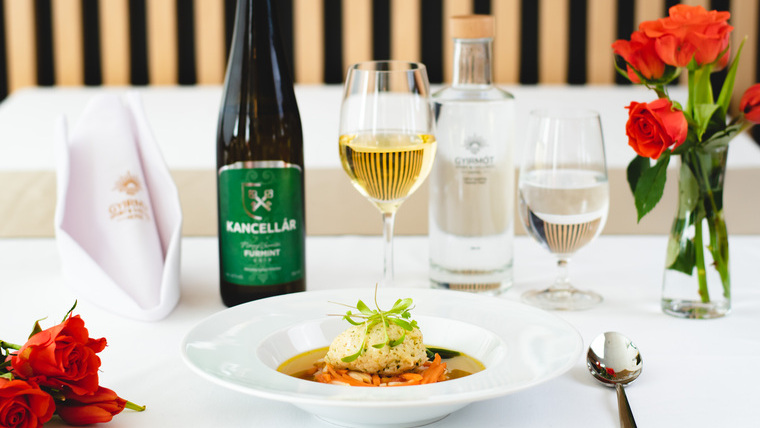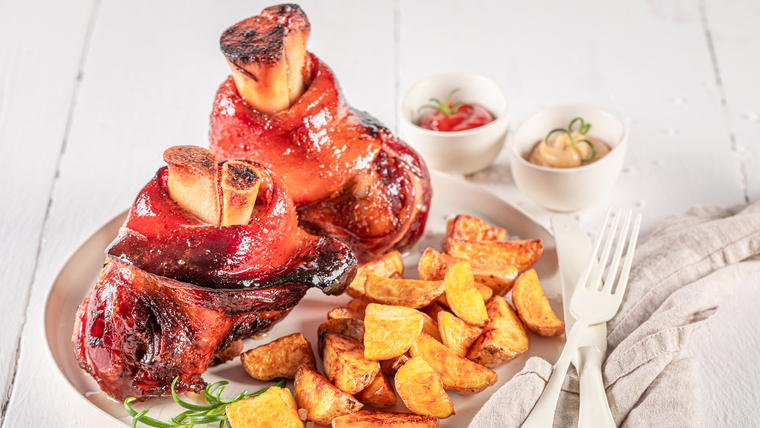FUNDAMENTALS
Bükk Vineyards used to serve other wine regions providing raw material for their mass-produced wines, which strongly determined the region’s current face. Tokaj wines were stored in Miskolc cellars for centuries; Törley, the legendary Hungarian sparkling wine maker sourced grapes from this area to his facilities around Budapest; the region has been involved in Eger’s Bikaver (Bull’s Blood) Programme and it is still an important raw material source for its western neighbour. This exploitation prevented the region from creating its own identity based on its real capabilities and strengths. Cold climate, felsic derived soil interwoven with strands of limestone do not support the production of distinctive wines based on the current varietal portfolio, where dominating whites are Leányka, Olaszrizling and Chardonnay, reds consist of Kékfrankos and Zweigelt. Distinctive Olaszrizling and Chardonnay can mostly be born on mafic derived soil and limestone bedrock. Leányka has no conspicuous characteristics it proved to be better as a balancing agent in blends. Distinctive reds cannot be produced in this region, either however the booming rosé fashion can provide a breeding ground for the planted blue varieties. The climate and the soil seem to be perfect for aromatic varieties such as Medina and Cserszegi Fűszeres, which are yet planted in a smaller volume. Based on personal stories I intend to describe my vision for a possible future development of this disadvantaged region.
ROOTS
I remember in the eighties’ song, Tone Loc queued up for a Funky Cold Medina cocktail in a bar to be seductive. A decade later, in the university dance club, I went crazy for the aromatic and sweet Medina wine to beef up the night. It was my beginning with this despised variety and with wines, too. Had it not been for Medina, I am certain that I would not have gained such a keen interest in wines. Being bored by the university drinking bouts, I unexpectedly started to taste the wine instead of drinking it. First, I tried to define its muscat-like and oriental tones that were sandwiched between the layers of sugar. Later, the insatiable appetite that I gained through the years shifted focus towards luscious dry whites like the award-winning mass-produced WoodCutter Cserszegi Fűszeres from Hilltop, being the link to the world of fine wines. Many years later, living already in the Bükk, I came across a hobby winemaker who gave me a Cserszegi Fűszeres wine equipped with a distinctively strong acidic spine carrying conspicuous elderberry flower aromas with hints of muscat tones, lime zest and gooseberry in the finish. These gave me an appreciable impetus to make wines from Medina as a hobbyist and pay close attention to the opportunities of Cserszegi Fűszeres as a connoisseur.
MEDINA AS A GREAT SPICE FOR ROSÉ
Although Medina is said to be a resistant grape variety, I had horticultural difficulties. No doubt, it is more resistant to oidium or peronospore than its mother grape (Menoire) but it is not resistant to insects as the hornets started to harvest it even at veraison. The oozing spicy muscat tones of the open berries attract smaller insects that are easy prey for the huge hornets. At the beginning of August, my first small vineyard looked like a battlefield full of dead insects and rotten grape berries. Getting through the initial viticultural hurdles it took several years to find the right style. At the beginning, my Medina rosé wines lacked acidity, substance, and style as I realised that Queen Medina needs a king to express beauty and her indispensable nature. Therefore, I started to rent an allotment full of Kékfrankos grapes. I have never believed that the Bükk region in Northern Hungary can provide powerful reds, therefore I focused solely on rosés. In this region, fermenting spontaneously, Kékfrankos gives an overspiced, racy and simple rosé wine that is best if it is mixed with sparkling water called “Fröccs” in Hungarian. If you add cultured yeasts, you end up with the same chewing gum aromas just like most rosés taste on supermarket shelves. Judging by her pros and cons Medina seemed to be the perfect companion to make my desired Tavel-style rosé. Kékfrankos provides body, strong structure, harsh spices, and acidity, where Medina smoothens the blend with its watery nature, low acidity, in addition to adding extra fine spices and floral tones. It acts like Cinsault or Picpoul in Southern-Rhone rosés. It perfectly worked in the vintages of 2019 and 2020 with approximately 25 % Medina in the blend. Medina’s contribution was extra floral tones and orange peel aromas, however in 2020 it saved the harvest with its flat body after a five-day-raining, which increased the already high acidity of Kékfrankos towards extremities.
CSERSZEGI FŰSZERES
Following my first encounter I paid attention to the variety all over the country with frequent tasting and talks with producers. I concluded that this variety shows the most masculine and versatile face in Bükk, presumably due to its climate and soil since tartaric acid is well preserved and the varietal’s inherent aromatic profile is not simplified to muscatel-like aromas, but it is able to burst with elderflower, gooseberry, and lime aromas, in addition to the popular aromatics. 2016 was a benchmark year for several reasons: sunshine hours, the volume and timing of rains were perfect, which resulted in rich texture and tones. Cserszegi Fűszeres is a delicate variety. Problems arise right after the berry touch as it is susceptible to white rot and botrytis in addition to damages caused by hornets and wasps. It produces great wines if it is taken care: low-yield production, removed lateral shoots and good weed management are necessary to bring powerful berries to the winery. To gain complex wines vinification practices are also important: 12-24 hours of skin contact releases further aromas and gives body, while spontaneous fermentation ensures that the grape can express a more complex palate than muscatel-like tones that are exaggerated by saccharomyces cerevisiae. In particular vintages, with the help of botrytis versatility can be further increased by botrytis cinerea.
CONCLUSION
Spontaneously fermented aromatic wines through white Cserszegi Fűszeres and Medina spiced Kékfrankos and/or Zweigelt rosé cuvee could be a possible breakthrough for the Bükk Region to make the points of difference in the wine world. I am not convinced that the existing varietal portfolio determined by “toll manufacturing” for Eger can hold the key to success. Bearing in mind that, changing the profile of a wine region takes several decades and significant financial resources I only intend to draw the attention of winemakers and wine enthusiasts towards these possibilities in the region, which I am certain will not lead to disappointment.

 Tavaszi kortyok nyomában a Winelovers Grandon
Tavaszi kortyok nyomában a Winelovers Grandon
 Melyik pizzához milyen bor illik?
Melyik pizzához milyen bor illik?
 "Számunkra ez a rendezvény már hagyománynak számít"
"Számunkra ez a rendezvény már hagyománynak számít"
 Egy nevezés – számtalan lehetőség! Miért éri meg nevezni a Winelovers Wine Awards-ra?
Egy nevezés – számtalan lehetőség! Miért éri meg nevezni a Winelovers Wine Awards-ra?
_1.jpg) Új cégvezető a Winelovers élén
Új cégvezető a Winelovers élén
 5 furmint a februári farsangi napokra
5 furmint a februári farsangi napokra
 “A bornak szerepe lehet a társadalmi rétegek közötti hidak építésében”
“A bornak szerepe lehet a társadalmi rétegek közötti hidak építésében”
 Egy pompás bor-étel pár a sommelier ajánlásával
Egy pompás bor-étel pár a sommelier ajánlásával
 HOLDVÖLGY Birtok, Mád
HOLDVÖLGY Birtok, Mád Borkóstoló
Borkóstoló HOLDVÖLGY Birtok, Mád
HOLDVÖLGY Birtok, Mád Borkóstoló
Borkóstoló